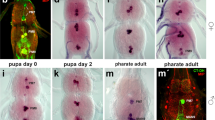Summary
The fact that the atrial gland ofAplysia californica contains peptides that will induce egg laying when injected into mature animals prompts consideration of the role played by the gland in the normal physiology of the animal. We have approached this consideration with a combination of morphologic and physiologic investigations. Morphologic study reveals the gland as a stratified epithelium comprised of three cell types. The only evidence for secretory activity was seen in the columnar epithelial cells containing large vesicular inclusions. These cells appear to discharge their secretory product into the lumen of the large hermaphroditic duct. While we cannot specify the contents of the secretion from the columnar cells, perfusate of the duct lumen contained bioassay active material only when the duct was exposed to depolarizing conditions. Though additional experiments in which exogenously administered atrial gland peptides were found to initiate egg laying in animals from which the source of the egg laying neurohormone had been extirpated, it appears likely that the atrial gland substances are not endocrine factors. Instead, their function must be sought among the exocrine products of the duct epithelium.
Similar content being viewed by others
Abbreviations
- FWS :
-
filtered artificial sea water
- LHD :
-
large hermaphroditic duct
References
Arch S (1972) Polypeptide secretion from the isolated parietovisceral ganglion ofAplysia californica. J Gen Physiol 59:47–50
Arch S (1976) Neuroendocrine regulation of egg laying inAplysia californica. Am Zool 16:167–175
Arch S, Earley P, Smock T (1976a) Biochemical isolation and physiologic identification of the egg-laying hormone inAplysia californica. J Gen Physiol 68:197–210
Arch S, Smock T, Earley P (1976b) Precursor and product processing in the bag cell neurons ofAplysia californica. J Gen Physiol 68:211–225
Arch S, Smock T, Gurvis R, McCarthy C (1978) Atrial gland induction of the egg laying response inAplysia californica. J Comp Physiol 128:67–70
Beeman R (1970) The anatomy and functional morphology of the reproductive system of the opisthobranch molluskPhyllaplysia taylori Dall, 1900. Veliger 13:1–31
Blankenship J (1980) Physiological properties of peptide secreting neuroendocrine cells in the marine molluscAplysia. Neurose Symp (in press)
Branton W, Arch S, Smock T, Mayeri E (1978) Evidence for mediation of a neuronal interaction by a behaviorally active peptide. Proc Natl Acad Sci USA 75:5732–5736
Chiu A., Hunkapiller M, Heller E, Stuart D, Hood L., Strumwasser F (1979) Purification and primary structure of the neuropeptide egg-laying hormone ofAplysia californica. Proc Natl Acad Sci USA 76:656–660
Dudek F, Blankenship J (1977) Neuroendocrine cells ofAplysia brasiliana. I. Bag cell action potentials and afterdischarge. J Neurophysiol 40:1301–1311
Eales N (1921)Aplysia. Liverpool Marine Biology Committee, Memoir No. 24, Proc Trans Liverpool Biol Soc 35:183–266
Frazier W, Kandel E, Kupfermann I, Waziri R (1967) Properties of identified neurons in the abdominal ganglion ofAplysia californica. J Neurophysiol 30:1288–1351
Heller E, Kaczmarek L, Hunkapiller M, Hood L., Strumwasser F (1980) Purification and primary structure of two neuroactive peptides that cause bag cell afterdischarge and egg-laying inAplysia. Proc Natl Acad Sci USA 77:2328–2332
Kaczmarek L, Jennings K, Strumwasser F (1978) Neurotransmitter modulation, phosphodiesterase inhibitor effects, and cAMP correlates of afterdischarge in peptidergic neurites. Proc Natl Acad Sci USA 75:5200–5204
Kaczmarek L, Finbow M, Revel J, Strumwasser F (1979) The morphology and coupling ofAplysia bag cells within the abdominal ganglion and in cell culture. J Neurobiol 10:535–550
Pearse A (1977) The diffuse neuroendocrine system and the APUD concept: Related “endocrine” peptides in brain, intestine, pituitary, placenta, and anuran cutaneous glands. Med Biol 55:115–125
Rothman B, Brownell P, Mayeri E (1979) Purified bag cell peptide mimicks some but not all responses of central neurons to bag cell stimulation inAplysia. Soc Neurosci Abstr 5:260
Sherman R, Atwood H (1972) Correlated electrophysiological and ultrastructural studies of a crustacean motor unit. J Gen Physiol 59:586–615
Strumwasser F, Jacklet J, Alvarez R (1969) A seasonal rhythm in the neural extract induction of behavioral egg laying inAplysia. Comp Biochem Physiol 29:197–206
Thompson T, Bebbington A (1969) Structure and function of the reproductive organs of three species ofAplysia (Gastropoda. Opisthobranchia). Malacologia 7:347–380
Author information
Authors and Affiliations
Additional information
Technical assistance for these studies was ably provided by Eugene Dannen and Gary Whitney. The surgical procedures were developed by Greg Thayer. Funding for the work was provided by NIH grant NS 11149 to S.A.
Rights and permissions
About this article
Cite this article
Arch, S., Lupatkin, J., Smock, T. et al. Evidence for an exocrine function of theAplysia atrial gland. J. Comp. Physiol. 141, 131–137 (1980). https://doi.org/10.1007/BF00611886
Accepted:
Issue Date:
DOI: https://doi.org/10.1007/BF00611886




